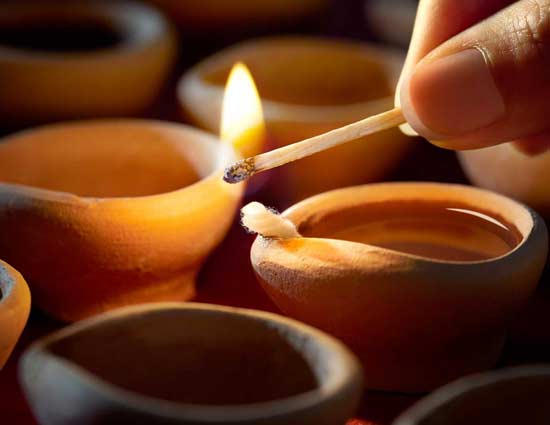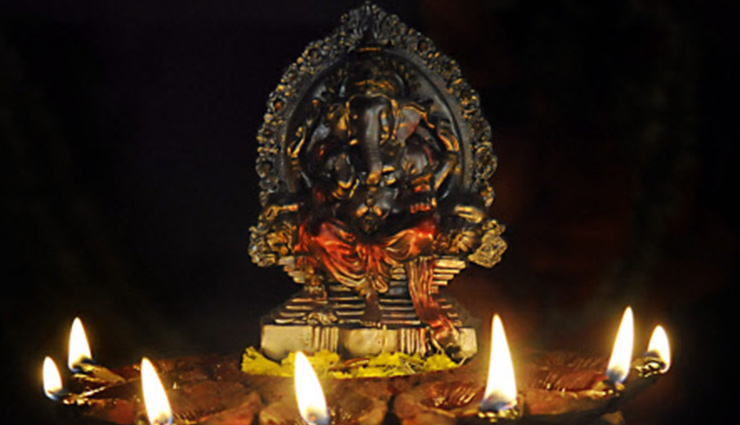History Of 4th Day Of Diwali– 2 Stories
By: Sandeep Thu, 12 Oct 2017 2:11:14

The history of Diwali is replete with legends and these legends are moored to the stories of Hindu religious scriptures, mostly the Puranas. Though the central theme of all legends point out to the classic truth of the victory of the good over the evils, the mode of their presentation and the characters differ. Diwali, being the festival of lights, lighting the lamp of knowledge within us means to understand and reflect upon the significant purpose of each of the five days of festivities and to bring those thoughts in to the day to day lives.
Lakshmi Puja
The fourth day is the main festive day. People wear new clothes or their best outfits as the evening approaches. Then diyas are lit, pujas are offered to Lakshmi, and to one or more additional deities depending on the region of India; typically Ganesha, Saraswati, and Kubera. Lakshmi symbolises wealth and prosperity, and her blessings are invoked for a good year ahead.
Lakshmi is believed to roam the earth on Diwali night. On the evening of Diwali, people open their doors and windows to welcome Lakshmi, and place diya lights on their windowsills and balcony ledges to invite her in. On this day, the mothers who work hard all year, are recognized by the family and she is seen to embody a part of Lakshmi, the good fortune and prosperity of the household. Small earthenware lamps filled with oil are lighted and placed in rows by some Hindus along the parapets of temples and houses. Some set diyas adrift on rivers and streams. Important relationships and friendships are also recognized during the day, by visiting relatives and friends, exchanging gifts and sweets.
After the puja, people go outside and celebrate by lighting up patakhe (fireworks). The children enjoy sparklers and variety of small fireworks, while adults enjoy playing with ground chakra, Vishnu chakra, flowerpots (anaar), sutli bomb, rockets and bigger fireworks. The fireworks signify celebration of Diwali as well a way to chase away evil spirits. After fireworks, people head back to a family feast, conversations and mithai (sweets, desserts).

Two Unforgotten Stories of Diwali Festival
# Return of Shri Ram To Ayodhyaa
The most well known story behind Diwali is in the Ramayana, the great Hindu epic. According to Ramayana, Rama, the prince of Ayodhya was ordered by his father, King Dasharatha, to go away from his country and come back after living in the forest for fourteen years. So Rama went on exile with his devoted wife Sita and faithful brother, Lakshmana. When Ravana, the demon king of Lanka abducted Sita and took her away to his island kingdom of Lanka, Rama fought against and killed Ravana. He rescued Sita and returned to Ayodhya after fourteen years. The people of Ayodhya were very happy to hear of their beloved prince’s homecoming. To celebrate Rama’s return to Ayodhya, they lit up their houses with earthen lamps (diyas), burst crackers and decorated the entire city in the grandest manner.
This is believed to have started the tradition of Diwali. Year after year this homecoming of Lord Rama is commemorated on Diwali with lights, fireworks, bursting of crackers and merriment. The festival gets its name Deepawali, or Diwali, from the rows (avali) of lamps (deepa) that the people of Ayodhya lit to welcome their King.
# Incarnation of the Goddess Lakshmi
It is also believed that on this very Diwali day, the Goddess of wealth, Lakshmi rose up from the ocean. The Hindu scriptures tell us that long long ago both Devas (gods) and Asuras (demons) were mortal. They had to die sometime or other, like us. But they wanted to live forever. So they churned the ocean to seek Amrita, the nectar of immortality (an event mentioned in the Hindu scriptures as “Samudra-manthan”), during which many divine objects came up. Prime among these was Goddess Lakshmi, the daughter of the king of the milky ocean, who arose on the new moon day (amaavasyaa) of the Kartik month. That very night, Lord Vishnu married her. Brilliant lamps were illuminated and placed in rows to mark this holy occassion. This event is supposed to have given rise to an annual celebration at the same time each year. Even today, Hindus celebrate the birth of the goddess Lakshmi and her marriage to Lord Vishnu on Diwali and seek her blessings for the coming year.





